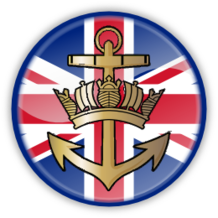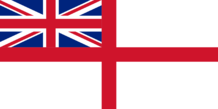Royal Navy
| ||||||||||||
| ||||||||||||
The Royal Navy, created in the run-up to Operation French Toast, was the main and largest fighting force of the British Armed Forces for over a year until it was disbanded on the 21st April 2010.
The "slow but powerful" aspect of the organization was a key feature of its design and it can be considered what the Navy lacks in per-person hitting power it compensates for with superior numbers. With the much larger amount of personal, this had led to the rise of a very prominent Navy community within the United Kingdom.
On the 27th January 2011, the Navy was re-activated after wide-spread military reforms.
In later January 2011, military reforms brought back the Navy as part of a tri-service structure. The New Navy's first commanding officer was Sven Goran Duran-Duran.
June 2011 Reform
The start of June 2011 saw the second reform which kept the Tri-service structure but removed the regiments and Executive commanding officers in favour of a run smaller command. The First Commander-in-Chief for this reform was Rear Admiral kdoggroundtwo with his two Commodores Lionbeard and Mini Munch.
Command Structure
- Commander-in-Chief Fleet: Rear Admiral Lionbeard
- Commanding Officer, HMS Queen Anne's Revenge: Captain Herman Anderson
- Commanding Officer, HMS Adventure Galley: Captain Louis Mountbatten
The New Navy began with the two ships HMS John F Baker and HMS Tom Morgan, named after the previous last Royal Navy CO and first Chief of the Defence Staff.
Ship Naming
The Royal Navy has a long tradition of commissioning ships named after retired Commanding Officers and important military officers & Ministers of Defence. This was carried into the New Navy with the commissioning of HMS John F Baker, last "old" Navy CO, and HMS Tom Morgan, first Chief of the Defence Staff without a named ship.
Ships were to be named after Chiefs of the Defence Staff and General Staff, and old Ministers of Defence, or Royal dignitaries. Under plans for expansion of the new navy, future ships were to be named:
- (HMS Jhorlin)
- HMS Hazz
- HMS Artela's Fist
- HMS King Kumnaa I
- HMS King Woldy I
Unfortunately, the branch never expanded beyond the two original ships, which were later renamed.
The original Royal Navy was created in November 2008 alongside the Paras and Royal Guard, in the run-up to the invasion of France by ATLANTIS, known as Operation French Toast. The Navy was first led by Hassan Pesaran, and was initially structured with army-style ranks and units in the same fashion as the Royal Guard.
- Royal Navy HQ (Brigadier CO)
- Alpha Company (Colonel OC, Captain 2IC)
- Squads/Platoons (Sergeant IC, Corporal 2IC, Private soldiers)
- Bravo Company
- Charlie Company
- Special Boat Service
- Alpha Company (Colonel OC, Captain 2IC)
This system was reformed by thehorseltd in the summer of 2009, and the 'navalised' structure that was left was relied on, almost without change, until the V1 Navy's demise. Around Christmas, the final step away from Army-hood occurred when Royal Navy privates became sailors, able rates, leading rates and in some circumstances royal marines.
The Old Navy took part in many operations throughout its service, taking a role in the invasion of the USA, countless European battles, the invasions of Norway and others. However, naval personnel were also deployed on commune rota, where Russia and Brazil served as month-long mining bases for fleets to produce iron for weapons. The old Navy had always, to a great extent, used self-manufactured supplies using its manpower.
The Old Navy came to an end in April as Version Two (V2) of eRepublik approached, and large military structural reforms would take place. The Royal Navy had no place in the land battles of V2, and on the 21st, it was disbanded, personnel transferred to the new British Army.
Fleet & Ship History
With the switch to naval naming, on the 23rd June 2009 thehorseltd commissioned the first few new ships into the navy using a few naming schemes. The first being cities in the UK, the second after past Commanding Officers of the Royal Navy and third after ships from Star Trek.
- HMS Belfast
- HMS Edinburgh
- HMS Will Salmon
- HMS Hassan Pessaran
- HMS Enterprise
- HMS Defiant
- HMS Voyager
As the navy expanded, a continuous flow of new ships, and eventually fleets, followed:
- July 2009 - AotF. Rodney Mckay
- HMS Cardiff - Southern & Caribbean Fleet
- HMS Solihull - Antarctic Fleet
- HMS Deadalus - Pacific Fleet
- HMS Aurora
- HMS Beliskner
- HMS thehorseltd - Atlantic Fleet
- September 2009 - AotF. R.R. Napier
- HMS Katana
- HMS Cutlass
- 22 December 2009 - AotF. fezoj (upon disbanding of the Royal Marines as a sub-branch of the Navy)
- HMS Funky - Indian Fleet
- HMS R.R. Napier
- HMS Accalia
- 07 January 2010 - AotF. R.R. Napier
- HMS Trooper C - Indian Fleet
- 15 January 2010 - AotF. R.R. Napier (upon creation of the newest sixth fleet, the Channel Fleet)
- HMS fezoj
- HMS Rodney Mckay
- transferred to the fleet: HMS Lionheart
| Southern & Caribbean Fleet |
Antarctic Fleet |
Atlantic Fleet |
Pacific Fleet |
Indian Fleet |
Channel Fleet |
|---|---|---|---|---|---|
| HMS Aurora | HMS Defiant | HMS fezoj | |||
(HMS Nice Guy Eddie) |
HMS Squiddy | HMS Enterprise | HMS Lionheart | ||
| HMS Edinburgh | HMS Excelsior | HMS Rodney Mckay | |||
| HMS London | HMS Will Salmon | ||||
After TheHorseLtd's navy-fication of the RN rank/command structure, the rank of Private remained in use at the lowest level until R.R. Napier introduced the ranks of Able and Leading Rate, for low and high activity sailors respectively. By the pass-over of command from Nice Guy Eddie to John F Baker, the then Minister of Defence and senior staff had standardised rank gradings for branch commanding officers, and CO Royal Navy was subsequently lowered from OF-11 (Admiral of the Fleet) to OF-10 (Admiral) in line with other branches.


